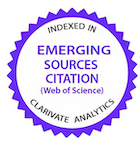Influência de fatores biológicos e de manejo sobre o leitão na fase de maternidade
DOI:
https://doi.org/10.1590/1809-6891v22e-67396Resumo
O objetivo deste trabalho foi avaliar os efeitos de manejo de uniformização, ordem de nascimento (ON), peso ao nascimento (PN) e suas interações no desempenho de leitões na fase de maternidade. Porcas (n = 25) e suas leitegadas (n = 388 leitões) foram distribuídas em dois tratamentos: UNIF – uniformização de leitões entre leitegadas distintas logo após o nascimento; MBIO – leitões mantidos até 12 horas pós-parto com a mãe biológica. Nos dois tratamentos o efeito da ON foi avaliado em três grupos caracterizados pela ON de 1–6, 7–12 e ≥ 13; o efeito de PN foi avaliado em quatro grupos definidos como Muito leve, Leve, Médio e Pesado. O delineamento foi inteiramente casualizado em esquema fatorial 2 × 3 × 4, totalizando 24 tratamentos com 16 leitões/tratamento, em média. O ganho de peso do nascimento até 72 horas de vida (GP72h) foi maior em MBIO. A quantidade de colostro ingerida (QCI) foi menor em leitões de ON ≥ 13. Em geral, o desempenho dos leitões aumentou em resposta ao aumento do PN. Houve interação entre manejo de uniformização e PN para QCI em relação ao peso corporal (QCIPC), que foi maior em leitões Muito leves em UNIF (27,48% PC) e menor em leitões Pesados em MBIO (16,82% PC). É possível obter bom desempenho de leitões mantendo a leitegada com a mãe biológica até 12 horas pós-parto. A quantidade de colostro ingerida em base absoluta (g) é maior, mas relativa ao peso corporal (% PC) é menor em leitões pesados.
Palavras-chave: colostro; desmame; hiperprolificidade; manejo de uniformização; peso ao nascimento; suinocultura.
Downloads
Referências
Beaulieu AD, Aalhus JL, Williams NH, Patience JF. Impact of piglet birth weight, birth order, and litter size on subsequent growth performance, carcass quality, muscle composition, and eating quality of pork. Journal of Animal Science [Internet]. 2010 Aug [cited 2020 Dec 05]; 88(8): 2767–2778. Available from: https://doi.org/10.2527/jas.2009-2222
Rutherford KMD, Baxter EM, D’eath RB, Turner SP, Arnott G, Roehe R, et al. The welfare implications of large litter size in the domestic pig I: biological factors. Animal Welfare [Internet]. 2013 May [cited 2020 Dec 05]; 22(2): 199-218. Available from: https://doi.org/10.7120/09627286.22.2.199
Baxter EM, Rutherford KMD, D'eath RB, Arnott G, Turner SP, Sandoe P, et al. The welfare implications of large litter size in the domestic pig II: management factors. Animal Welfare [Internet]. 2013 May [cited 2020 Dec 05]; 22(2): 219-238. Available from: https://doi.org/10.7120/09627286.22.2.219
Quesnel H, Farmer C, Devillers N. Colostrum intake: influence on piglet performance and factors of variation. Livestock Science [Internet]. 2012 July [cited 2020 Dec 05]; 146(2-3): 105-114. Available from: https://doi.org/10.1016/j.livsci.2012.03.010
Quiniou N, Dagorn J, Gaudré D. Variation of piglets’ birth weight and consequences on subsequent performance. Livestock Production Science [Internet]. 2002 Nov 28 [cited 2020 Dec 05]; 78(1): 63-70. Available from: https://doi.org/10.1016/S0301-6226(02)00181-1
Fix JS, Cassady JP, Herring WO, Holl JW, Cullbertson MS, See MT. Effect of piglet birth weight on body weight growth, backfat, and longissimus muscle area of commercial market swine. Livestock Science [Internet]. 2010 Jan [cited 2020 Dec 05]; 127(1): 51-59. Available from: https://www.sciencedirect.com/science/article/abs/pii/S1871141309002996
Kilbride AL, Mendl M, Statham P, Held S, Harris M, Cooper S, et al. A cohort study of preweaning piglet mortality and farrowing accommodation on 112 commercial pig farms in England. Preventive Veterinary Medicine [Internet]. 2012 May [cited 2020 Dec 06]; 104(3-4): 281-291. Available from: https://doi.org/10.1016/j.prevetmed.2011.11.011
Rooke JA, Bland IM. The acquisition of passive immunity in the new-born piglet. Livestock Production Science [Internet]. 2002 Nov 28 [cited 2020 Dec 06]; 78(1): 13-23. Available from: https://doi.org/10.1016/S0301-6226(02)00182-3
Xu RJ, Wang F, Zhang SH. Postnatal adaptation of the gastrointestinal tract in neonatal pigs: a possible role of milk-borne growth factors. Livestock Production Science [Internet]. 2000 Oct [cited 2020 Dec 07]; 66(2): 95–107. Available from: https://doi.org/10.1016/S0301-6226(00)00217-7
Klobasa F, Werhahn E, Butler JE. Composition of sow milk during lactation. Journal of Animal Science [Internet]. 1987 May [cited 2020 Dec 07]; 64(5): 1458-1466. Available from: https://doi.org/10.2527/jas1987.6451458x
Devillers N, Le Dividich J, Prunier A. Influence of colostrum intake on piglet survival and immunity. Animal [Internet]. 2011 [cited 2020 Dec 07]; 5(10): 1605-1612. Available from: https://doi.org/10.1017/S175173111100067X
Le Dividich J. A review-neonatal and weaner pig: management to reduce variation. In: Cranwell PD, editor. Manipulating Pig Production VII: proceedings of the Seventh Biennial Conference of the Australasian Pig Science Association-Apsa [Internet]. Adelaide (AU): Australian Pig Science Association; 1999 [cited 2020 Dec 07]. v. 7, p. 135-155. Available from: https://hal.inrae.fr/hal-02771776
Cutler RS, Fahy VA, Spicer EM, Cronin GM. Pre-weaning mortality. In: Straw BE, D’allaire S, Mengeling WL, Taylor DJ. Diseases of swine. 8nd ed. Ames (IA): Iowa State University Press; 1999. 985-1002.
Huting AMS, Almond K, Wellock I, Kyriazakis I. What is good for small piglets might not be good for big piglets: The consequences of cross-fostering and creep feed provision on performance to slaughter. Journal of Animal Science [Internet] 2017 Nov; [cited 2021 Feb 14]; 95(11):4926-4944. Available from: https://doi.org/10.2527/jas2017.1889
Bierhals T, Magnabosco D, Ribeiro RR, Perin J, da Cruz RA, Bernardi ML, et al. Influence of pig weight classification at cross-fostering on the performance on the primiparous sow and the adopted litter. Livestock Science [Internet]. 2012 July [cited 2020 Dec 08]; 146(2-3): 115-122. Available from: https://doi.org/10.1016/j.livsci.2012.02.026
Pajžlar, L, Skok, J. Cross-fostering into smaller or older litter makes piglets integration difficult: Suckling stability-based rationale. Applied Animal Behavior Science [Internet] 2019 Aug [cited 2020 Dec 21]; 220, 104856. Available from: https://doi.org/10.1016/j.applanim.2019.104856
Zhang, X.; Wang, M.; He, T.; Long, S.; Guo, Y.; Chen, Z. Effect of different cross-fostering strategies on growth performance, stress status and immunoglobulin of piglets. Animals [Internet] 2021 Feb; 11 (2), 499. Available from: https://doi.org/10.3390/ani11020499
Neal MS, Irvin KM. The effects of crossfostering pigs on survival and growth. Journal of Animal Science [Internet]. 1991 Jan [cited 2020 Dec 08]; 69(1): 41-46. Available from: https://doi.org/10.2527/1991.69141x
Straw BE, Dewey CE, Burgi EJ. Patterns of crossfostering and piglets mortality on commercial U.S. and Canadian swine farms. Preventive Veterinary Medicine [Internet]. 1998 Jan [cited 2020 Dec 08]; 33(1-4): 83-89. Available from: https://doi.org/10.1016/S0167-5877(97)00051-2
Robert S, Martineau GP. Effects of repeated cross-fostering on preweaning behavior and growth performance of piglets and on maternal behavior of sows. Journal of Animal Science [Internet]. 2001 Jan [cited 2020 Dec 08]; 79(1): 88-93. Available from: https://doi.org/10.2527/2001.79188x
Calderón Díaz JA, García Manzanilla E, Diana A, Boyle LA. Cross-fostering implications for pig mortality, welfare and performance. Frontiers in Veterinary Science [Internet] 2018 Jun 6 [cited 2021 Feb 14]; 5:123. Available from: https://doi.org/10.3389/fvets.2018.00123
Mores N, Sobestiansky J, Wentz I, Moreno AM. Manejo do leitão desde o nascimento até o abate. In: Mores N, Sobestiansky J, Wentz I, Moreno AM, editors. Suinocultura intensiva: produção, manejo e saúde do rebanho. [Internet]. Brasília (DF): Embrapa/Serviço de Produção de Informação-SPI; Concórdia (SC): Embrapa/Centro Nacional de Pesquisa de Suínos e Aves-CNPSA; 1998 [cited 2020 Dec 08]. p. 135-162. Available from: https://www.bdpa.cnptia.embrapa.br/consulta/busca?b=ad&id=434884&biblioteca=vazio&busca=autoria:%22MORENO,%20A.%22&qFacets=autoria:%22MORENO,%20A.%22&sort=&paginacao=t&paginaAtual=1. Portuguese.
Bandrick M, Pieters M, Pijoan C, Molitor T. W. Passive transfer of maternal Mycoplasma hyopneumoniae-specific cellular immunity to piglets. Clinical and Vaccine Immunology [Internet]. 2008 Mar [cited 2020 Dec 08]; 15(3): 540-543. Available from: https://doi.10.1128 /CVI.00466-07
Williams PP. Immunomodulating effects of intestinal absorbed maternal colostral leukocytes by neonatal pigs. Canadian Journal of Veterinary Research [Internet]. 1993 Jan [cited 2020 Dec 09]; 57(1): 1-8. Available from: https://www.ncbi.nlm.nih.gov/pmc/articles/PMC1263580
Beyer M, Jentsch W, Kuhla S, Wittenburg H, Kreienbring F, Scholze H, et al. Effects of dietary energy intake during gestation and lactation on milk yield and composition of first, second and fourth parity sows. Archives of Animal Nutrition [Internet]. 2007 Nov [cited 2020 Dec 09]; 61(6): 452-468. Available from: https://doi.org/10.1080/17450390701563433
Devillers N, Van Milgen J, Prunier A, Le Dividich J. Estimation of colostrum intake in the neonatal pig. Animal Science [Internet]. 2004 Apr [cited 2020 Dec 09]; 78(2): 305-313. Available from: https://doi.org/10.1017/S1357729800054096
Devillers N, Farmer C, Le Dividich J, Prunier A. Variability of colostrum yield and colostrum intake in pigs. Animal [Internet]. 2007 [cited 2020 Dec 05]; 1(7): 1033-1041. Available from: https://doi.org/10.1017/S175173110700016X
SAS – Statistical Analysis System (2002). SAS user's guide: statistics, version 9.0. Cary: SAS Institute.
Loving CL, Brockmeier SL, Vincent AL, Gauger PC, Zanella EL, Lager KM, et al. Cross-fostering to prevent maternal cell transfer did not prevent vaccine-associated enhanced respiratory disease that occurred following heterologous influenza challenge of pigs vaccinated in the presence of maternal immunity. Viral Immunology [Internet]. 2014 Sept [cited 2020 Dec 06]; 27(7): 334–342. Available from: https://doi.org/10.1089/vim.2014.0034
Picone G, Zappaterra M, Luise D, Trimigno A, Capozzi F, Motta V, Davoli R, Nanni Costa L, Bosi P, Trevisi P. Metabolomics characterization of colostrum in three sow breeds and its influences on piglets' survival and litter growth rates. Journal of Animal Science and Biotechnology [Internet]. 2018 Mar [cited 2020 Oct 12]; 20(1): 75-85. Available from: https://doi.org/10.1186/s40104-018-0237-1
León MY. Efeito da amamentação parcelada sobre o comportamento e a ingestão de colostro em leitões recém-nascidos (master’s thesis on the Internet]. Palotina (PR): Programa de Pós-Graduação em Ciência Animal, Universidade Federal do Paraná, Setor Palotina; 2018 [cited 2020 Dec 10]. 85 p. Available from: https://www.prppg.ufpr.br/siga/visitante/trabalhoConclusaoWS?idpessoal=54807&idprograma=40001016077P6&anobase=2018&idtc=51.
Fraser D, Rushen J. Colostrum intake by newborn piglets. Canadian Journal of Animal Science [Internet]. 1992 Mar [cited 2020 Dec 10]; 72(1): 1-13. Available from: https://cdnsciencepub.com/doi/pdf/10.4141/cjas92-001.
Le Dividich J, Charneca R, Thomas F. Relationship between birth order, birth weight, colostrum intake, acquisition of passive immunity and pre-weaning mortality of piglets. Spanish Journal of Agricultural Research [Internet]. 2017 June [cited 2020 Dec 09];15(2): 1-10. Available from: https://doi.org/10.5424/sjar/2017152-9921
Ferrari CV, Sbardella PE, Bernardi ML, Coutinho ML, Vaz Jr. IS, Wentz I, et al. Effect of birth weight and colostrum intake on mortality and performance of piglets after cross-fostering in sows of different parities. Preventive Veterinary Medicine [Internet]. 2014 June 1 [cited 2020 Dec 10]; 114(3-4): 259-266. Available from: https://doi.org/10.1016/j.prevetmed.2014.02.013
Wang X, Zhu Y, Feng C, Lin G, Wu G, Li D, Wang J. Innate differences and colostrum-induced alterations of jejunal mucosal proteins in piglets with intra-uterine growth restriction. British Journal of Nutrition [Internet]. 2018 Apr[citec 2021Feb 08] 119(7):734-747. Available from: https://doi.org/10.1017/S0007114518000375
Declerck I, Sarrazin S, Dewulf J, Maes D. Sow and piglet factors determining variation of colostrum intake between and within litters. Animal [Internet]. 2017 Aug [cited 2021 Jan 07] ;11(8):1336-1343. Available from: https://doi.org/10.1017/S1751731117000131
Mu C, Bian G, Su Y, Zhu W. Differential effects of breed and nursing on early-life colonic microbiota and immune status as revealed in a cross-fostering piglet model. Applied Environmental Microbiology [Internet]. 2019 Apr 18 [cited 2021 Feb 03];85(9):e02510-18. Available from: https://doi.org/10.1128/AEM.02510-18
Tuboly S, Bernáth S, Glávits R, Medveczky I. Intestinal absorption of colostral lymphoid cells in newborn piglets. Veterinary Immunology and Immunopathology [Internet]. 1988 Dec [cited 2020 Dec 08]; 20(1): 75-85. Available from: https://doi.org/10.1016/0165-2427(88)90027-X
Maradiaga, N. , Aldridge, B. , Zeineldin, M. , & Lowe, J. (2018). Gastrointestinal microbiota and mucosal immune gene expression in neonatal pigs reared in a cross-fostering model. Microbial Pathogenesis [Internet] 2018 Aug [cited 2021 Feb 03] ;121:27-39. Available from: https://doi.org/10.1016/j.micpath.2018.05.007
Downloads
Publicado
Como Citar
Edição
Seção
Licença
Copyright (c) 2021 Ciência Animal Brasileira

Este trabalho está licenciado sob uma licença Creative Commons Attribution 4.0 International License.
Autores que publicam nesta revista concordam com os seguintes termos:
- Autores mantém os direitos autorais e concedem à revista o direito de primeira publicação, com o trabalho simultaneamente licenciado sob a Licença Creative Commons Attribution que permite o compartilhamento do trabalho com reconhecimento da autoria e publicação inicial nesta revista.
- Autores têm autorização para assumir contratos adicionais separadamente, para distribuição não-exclusiva da versão do trabalho publicada nesta revista (ex.: publicar em repositório institucional ou como capítulo de livro), com reconhecimento de autoria e publicação inicial nesta revista.
- Autores têm permissão e são estimulados a publicar e distribuir seu trabalho online (ex.: em repositórios institucionais ou na sua página pessoal) a qualquer ponto antes ou durante o processo editorial, já que isso pode gerar alterações produtivas, bem como aumentar o impacto e a citação do trabalho publicado (Veja O Efeito do Acesso Livre).






























